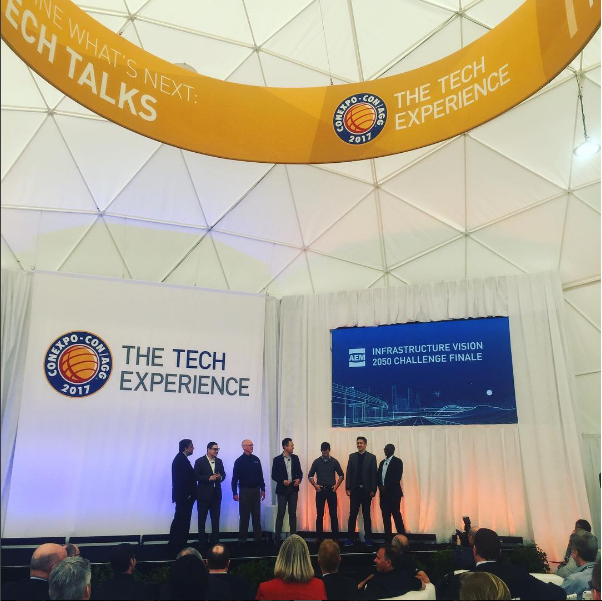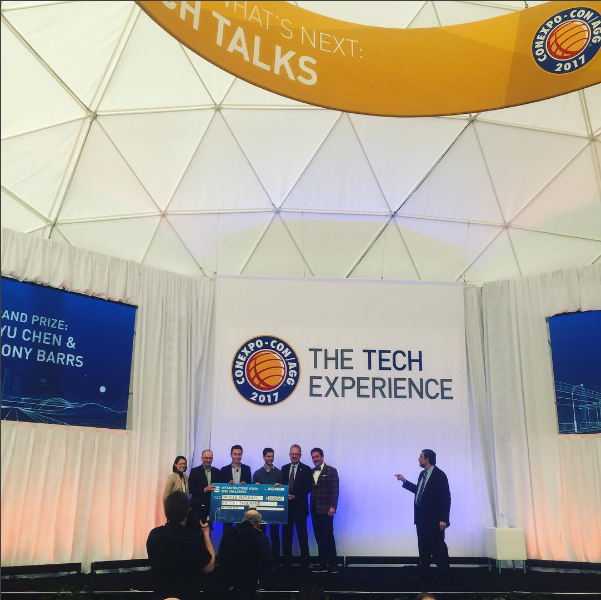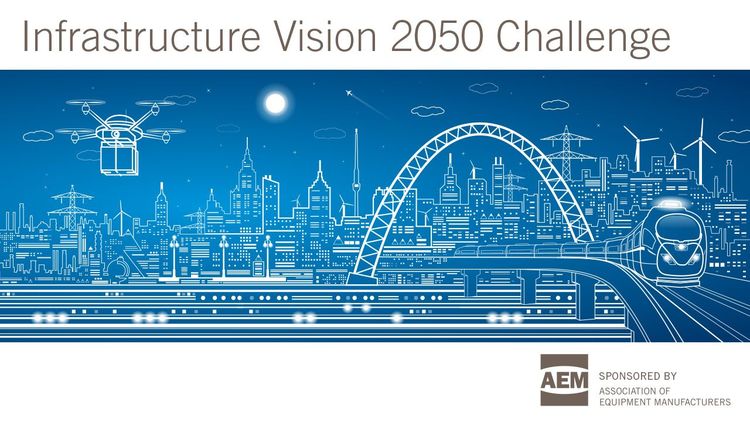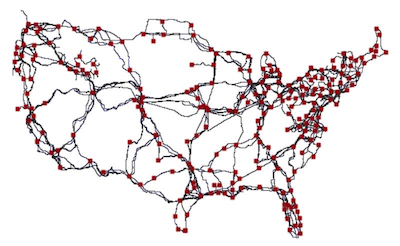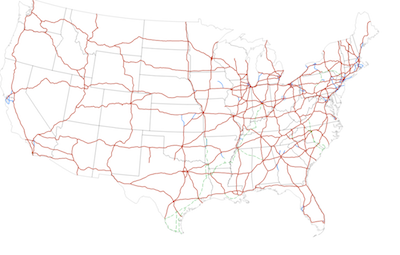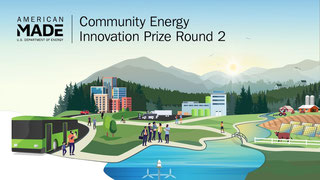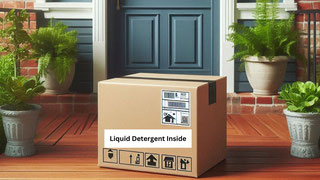The Problem
Infrastructure. We all know what the problems are, right?
- Congested highways
- Crumbling bridges
- Unreliable transit
We’ve all heard the statistics:
- The average American spends 38 hours each year stuck in traffic.
- 11 percent of the nation’s rural bridges are rated as structurally deficient.
- Nationally a pedestrian is killed every two hours.
We’ve all heard it. We all know it. But what are we doing about it?
It has been 60 years since the United States’ last major infrastructure project: the Interstate Highway System. That system has served us well, but it has not kept pace with advancements in transportation technology or shifts in population trends.

Mass transit systems, once a viable alternative to personal vehicles, have shown a startlingly sharper decrease in performance over the last 20 years, calling into question their long-term viability.

The Association of Equipment Manufacturers (AEM) believes there is a better, even more innovative, way to move people from their starting Point A to their destination Point Z more quickly, efficiently and safely than today’s systems. We believe that you, the problem-solver community, can create that better way.
The Breakthrough
For the final phase of the Infrastructure Vision 2050 Challenge, we want you to design a transportation system that can carry people from wherever they are to wherever they want to go, and do so in a way that far exceeds the efficiency and safety of today’s transportation models.
The most beautifully designed transportation system is doomed to fail if it is not accepted by its intended users, so a successful solution will mitigate the issues that prevent user buy-in, including, but not limited to:
- Total travel time and total connections
- Frequency or reliability/predictability of service
- Availability of connections from a person’s residence or place of business to the main system arteries, for a total trip solution
- Reach from central business areas into outlying areas
- Resilience and accommodation for rider use in inclement weather
- Total user capacity, including flexibility during peak travel times
We know you have incredible solutions for the transportation systems of the year 2050 and beyond, and we want you to share them with us. Submit your solutions to the Infrastructure Vision 2050 Challenge for your chance at a piece of the $100,000 grand prize -- plus incredible exposure for your ideas!
Finalists will be flown to Las Vegas for the 2017 CONEXPO-CON/AGG show where they will present their solutions, in person, to a judging panel of industry experts. The most innovative entries will also be displayed as part of the CONEXPO-CON/AGG Tech Experience. Sure to be one of the highlights of the expo, the Tech Experience will draw over 100,000 visitors throughout the five-day event...and your idea could be showcased for all to see.

Finalists will be flown to Las Vegas to present their solutions at CONEXPO-CON/AGG 2017.
Click over to the Guidelines page to learn what you need to do to submit your solution for your chance at prize money and a trip to Vegas to network with industry leaders.
THE PRIZE
The challenge is an opportunity to showcase transportation solutions you have always had, or ones you have recently envisioned. Solutions are welcome from anyone, whether or not you have a background in infrastructure design.
Teams entering the competition will:
- Identify a type of trip that is frequently made, and conditions for the area where it is made
- Create a transportation infrastructure system that includes all of the successful submission elements, as outlined in the Submission Form below
- Submit the solution, including strong visualization support
You must use metrics from various sources to support the case for your system(s). Both quantified data and subjective research are allowed, or a powerful combination of the two. It is useful for the judges to view references for secondary information, and actual outcomes for primary sources.
Examples of metrics for transportation infrastructure solutions:
- Solution for a medium sized population of 3 million people. System can move 200,000 people into the core urban area (one square mile) every hour, by using three “feeder” systems and a key central transit system. User satisfaction for travel time during rush hour is better than their current method of commuting.
- Solution for a large area that builds on existing transportation infrastructure. System expands the service area by increasing the capacity for transportation in order to reach the outlying suburbs. Solution enables 25% more people to use a transportation system for commuting by 2050.
- Solution for a small area with high population density and heavy reliance on personal vehicles. Solution achieves reduction in total end-to-end transportation from current average of 55 minutes down to 35 minutes.
Transportation systems can be structured in a number of ways:
- A combination of transportation systems/solutions
- An independent transportation system -- so long as the solution can move people from their starting destination all the way to final destination
- A hybrid solution that moves people by private car at one section of the trip and a series of other transportation systems for the rest of the trip
The transportation system must focus on complete, single trips that people make frequently – to/from work, to run errands in their community, or perhaps to visit family in a neighboring town.
Innovators who enter the competition may propose any solution to be built from now to 2050 and beyond. Teams should note the trends or needs that define the problem and how these correspond to their proposed solution.
Prizes
The competition offers a $100,000 USD prize total for the best desirable transportation infrastructure systems that can move large volumes of users from starting point to final destination.
- Grand prize: US $50,000
- Second place prize: US $35,000
- Third place prize: US $15,000
The road to the grand prize is:
- Finalists: 5 Innovators will be selected by judging panel
- Winners: The Finalists will present their ideas in person at CONEXPO-CON/AGG; winners will be selected from this group
Finalists will be flown to the 2017 CONEXPO-CON/AGG show (March 7-11, 2017) in Las Vegas to present their submission, in person, to judges and infrastructure leaders. Once the show starts and excitement is high, the final part of the judging will occur during a shark-tank style event.
CONEXPO-CON/AGG is an international trade show held every three years and is an industry powerhouse for infrastructure capability. With over 2,400 exhibitors and tens-of-thousands of attendees, Finalists will receive tremendous exposure for their solutions (in addition to receiving other media coverage). Solutions or elements from any entry may also be displayed at the show, regardless of whether that entry is selected as a Finalist.
The Association of Equipment Manufacturers will have a major presence at CONEXPO-CON/AGG, and looks forward to displaying the solutions generated from this challenge at the event.
SUBMISSION
The competition is your canvas! We seek submissions that are both well conceived, quantified, and robust, as well as descriptive, thoughtful, and clever innovations. Both individual innovators and teams of innovators may submit entries.
Written submission. The written proposal part of your entry must be submitted only within the Submission Form. Written submissions are limited to a maximum of 5,000 words. Embedded hyperlinks to external content, such as videos or animations (recommended maximum 2-3 minutes duration) are allowed and encouraged in the written proposal. All physical supporting media must be received by the Association of Equipment Manufacturers by the deadline in order to be considered for judging.
Supporting materials for submission. A key part of the competition is the depiction and visualization of the solution. As part of this, innovators must submit a visual depiction of their solution in addition to the written portion of their submission. Teams may use photos, drawings, diagrams, 2-D or 3-D renderings, physical models, video, digital media and/or other visual formats. There is no limit on supporting materials that illustrate and make the story of your transportation system come to life for the viewer/reviewer of the entry.
If an innovator chooses to submit physical supporting materials which cannot be sent electronically (i.e. a 3D model), the innovator will be responsible for shipping the materials to AEM. These materials will become the property of AEM unless the team (a) requests the components be shipped back, (b) provides shipping and packaging instructions/materials, and (c) pays the cost of shipping. Innovators must request for the return of components by the submission deadline.
Innovators shall retain all rights to the intellectual property (“IP”) in conjunction with the submission for the competition.
Submission Form
Description of the infrastructure system(s)
1) What type of overall infrastructure system(s) are you submitting, and how will it/they operate? This question is asking for a brief, factual categorization with top level features/benefits or application.
2) Describe the concept or the vision for your system(s). You can tell the “story” of your system via a narrative or illustrative description, use cases, differentiators, or other method. This can include your inspiration, vision, or impetus for creation, as well as other details.
3) What kinds of technologies and construction methods form the basis of your system? You may provide specifications here as needed for the reviewers to gain a thorough grasp of the current or future mechanisms, techniques, or approaches you will use.
4) How does the system(s) solve or improve transportation for frequent trips? Your solution should specify the type of area it will serve:
- ‘Smaller’ - under 2 million people
- ‘Medium’ - 2 to 3.9 million people
- ‘Larger’ - 4 to 7.9 million people
- ‘Mega’ - 8 million+ people
5) Explain the capacity (number of users) that can be accommodated for each component of the transportation system. These should be expressed in metrics for each system, such as:
- Capacity per unit of distance
- Capacity per unit of time
- Total time per user per segment to move people
6) Explain the connectivity of the system: how people will use your system to make complete trips from point A to point B, without gaps. This should include any system elements, connectivity and linkages needed to provide the total transportation experience. Think of this as a step-by-step walkthrough of the user’s progression through the system, from the front door of their departure point to the front door of their destination.
User acceptance
7) What are the user thresholds and expected satisfaction for your future system? These thresholds are the level of benefits to users and/or tradeoffs they are willing to make, such as:
- What is the maximum time a user is willing to spend to reach a final destination?
- How many transit segments would a user be willing to accept?
- What is the minimum comfort level that could be considered viable for the transportation infrastructure?
8) Basis of assumptions for user acceptance
- What is your basis, source, and/or methods of research or discovery for setting the user thresholds and expected satisfaction for your future system?
- Explain any testing you have done to establish or validate your user satisfaction metrics
Coverage
9) What is the coverage of users for your submission? Specify both who and where the system(s) is intended to cover. For example, you may be submitting a medium transportation system for 3 million people:
- Part A of your system is to cover a surrounding geographical area of xx miles2, and x% of that population
- Part B of your system moves people from a different surrounding geographical area of xx miles2, and x% of that population
- Part C of your system is a high density environment of xx people moving from surrounding areas, into a concentrated area of x miles in a 2-hour period
System adaptability
10) How will your system adapt to handle peak transit time needs, inclement weather, safety issues, delays, special needs riders, or other specific elements. Note the system’s tradeoffs needed to achieve this flexibility.
JUDGING CRITERIA
Innovators will be judged using the scorecards below.
Finalist judging criteria
To ensure that submissions have the underlying viability, there is a heavier focus on technical criteria in Finalist judging. All solutions will be judged against this criteria to be amongst the five finalists in the challenge.
40 Points: Physical and Technical Demonstration of Concept
| 10 points |
Viability and robustness of the system’s functionality, supported by proof or demonstration of concept, pilot/test trials, and/or simulations to substantiate that the system is or would be operable and feasible |
| 15 points |
System buildability, including support/substantiation for how the system would be constructed and how it could be built and operated in its stated environment. |
| 15 points |
Interconnectedness of solution including support/substantiation for the overall transportation network, linkages between systems, and the ability of the system to provide a complete trip. |
40 points Subtotal for Physical and Technical Demonstration of Concept
30 Points: Physical and Technical Specifications
| 10 points |
Adaptability to special conditions, particularly peak travel times where the system is full or overloaded
|
| 10 points |
Capacity to move people, including the calculations of movement, the smartness of the solution to move the stated number of people, or the time needed to move people
|
| 5 points |
Coverage of geographical areas, including the extent to which the system reaches the area selected, the appropriateness of the solution for the population size, the coverage area, and the transportation method submitted for these
|
| 5 points |
Ingenuity of the solution, which can be derived from the simplicity of the solution, the means by which a complex series of solutions is made viable, or other means for original and creative innovation
|
30 points Subtotal for Physical and Technical Specifications
All Physical/Technical presentation subcategories will consider both the benefit of the system as well as drawbacks; consideration will be given for judicious tradeoffs made among competing technical elements.
10 Points: Quantification
Points awarded for:
- Definition/presentation of the solution in terms of metrics (not only conceptual or abstract ideas)
- Use of data, research, or other facts to support the physical/technical viability and user acceptance
10 Points: User Acceptance
Points awarded for:
- Consideration for users’ wants, needs, preferences, thresholds and tradeoffs
- Development of the total system around these user principles
10 Points: Portrayal of the Solution
Points awarded for the team’s ability to present its solution in a complete, cohesive, and convincing manner. Judges will look for the portrayal of the submission as an intricately woven narrative to the problem that is defined by the team.
100 Points Finalist TOTAL
Winners Judging Criteria
Visualization and physical presentation of the solution is also an important requirement. Winning entries must be brought to life for the CONEXPO-CON/AGG viewing public, thus there is a heavier focus on this aspect. As one of the five Finalists, your submission will be judged against these criteria to be selected as a winner for the challenge.
Note that your submission must take into account both the Finalist and Winners Judging Criteria for your submission.
40 points: Telling “The Story”
Ability for the team to engage judges by explaining and presenting “the story” of their transportation infrastructure solution for moving people.
| 15 points |
Judicious presentation of information that weaves facts and stats together with a narrative to create a compelling story |
| 10 points |
Premise for the need to move people, and how the solution considers key future trends/needs, and why the team feels the system will be successful |
| 10 points |
Bringing the solution to reality via the metrics, technical
elements, and proof of the concept |
| 5 points |
Journey of the team’s process in envisioning and creating the solution |
40 points Subtotal for Telling the Story
40 points: Physical Depiction or Display of the Solution
| 30 points |
Use of supporting materials such as photos, video, renderings, simulation, physical 3D models or other media to visualize the solution. Note that innovators will have the opportunity to present their choice of any supporting materials that were submitted by the deadline (which may or may not include their display materials in the AEM Hub at CONEXPO-CON/AGG).
|
| 10 points |
Value add of these materials to be illustrative, convincing, and appropriate for the solution. Supporting materials and media which have particular applicability to the proposed solution will be considered for points here.
|
40 points Subtotal for Physical Depiction or Display of the Solution
20 points: Delivery of a captivating and convincing in-person presentation (“pitch”) to the judging panel. Points will be given for the extra punch and flair provided through personal presentation, instead of just a static display. Note that innovators will be given 5 minutes to present their submission and make an impression.
100 Points Winner TOTAL
Timeline
7/13/2016 Prize official launch
12/15/2016 Submission deadline
12/16/2016 Judging to determine Finalists begins
1/5/2017 Judging to determine Finalists ends
1/12/2017 Finalists announced/notified
3/7/2017 CONEXPO-CON/AGG show in Las Vegas starts (Mar 7-11)
3/8/2017 Finalists present their solutions in Las Vegas to judges
WHAT CAN YOU DO RIGHT NOW?
- Click the “Start here” button above to compete in the challenge.
- Click the “Follow” button above to be notified of any updates.
- Read the FAQ to get answers to commonly asked questions. The FAQ will be updated throughout the duration of the challenge, so check back often for new information.
- Share this challenge with your friends and family or anyone who might be interested in being part of the next great breakthrough in transportation infrastructure. You can use the social media buttons beneath the challenge image above to share this page.
- Leave a comment in our Forum to join the conversation, ask questions, or connect with other innovators.
ADDITIONAL RULES
Participation Eligibility: The Challenge is open to all individuals, private teams, public teams, and collegiate teams. Teams may originate from any country. Submissions must be made in English. All prize-related communication will be in English.
No specific qualifications or expertise in working with transportation infrastructure or systems is required.
To be eligible to compete, you must comply with all the terms of the Challenge as defined in the Challenge-Specific Agreement.
Registration and Submissions: Submissions must be made online (only), via upload to the HeroX.com website, on or before dates noted on timeline by noon EST. All uploads must be in PDF format; physical models may be photographed or videotaped and submitted electronically. No late submissions will be accepted.
Selection of Winners: Based on the winning criteria, 3 total prizes will be awarded per the Judging Criteria section above. A qualified Judging Panel will determine winners.
Judging Panel: The determination of the winners will be made by a group of people including thought leaders, influencers, and people with unique insight into transportation infrastructure and systems. Judges will have expertise in these areas, as well as urban planning, industrial design, project management, or graphic display and presentation.
As importantly, the Judging Panel may also include Judges who have expertise in future trend forecasting and user experience design/satisfaction, but little background or experience related to infrastructure. The intent of including these individuals is to include the perspective of users as well as creators of transportation infrastructure.
